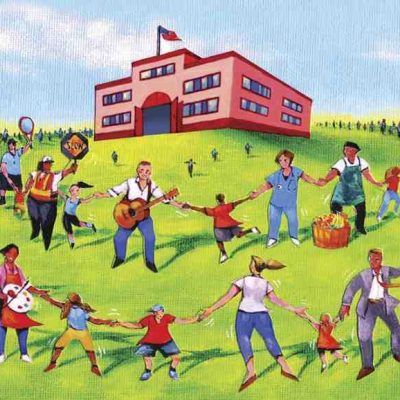Don’t tune out music programs
Music programs in schools are drastically underfunded, and in some cases not present at all. And that could have disastrous consequences for an already suffering generation. Public schools have always struggled with getting proper funding. This isn’t a challenge unique to any particular area or time — it’s always been an issue with our school system. But it’s become a much bigger problem in the wake of COVID, especially in programs centered around music, sports and the fine arts.
Most people are aware that public schools have limited budgets, and that each year it’s decided — in Massachusetts by the state Department of Education, and not by local authorities like towns and cities — how much money is devoted to each institution. Plenty of us have heard about the great benefit that sports and physical activity can provide for students, especially those in middle and high school. But less people know about, or want to think about, the cuts to music, art, and other ‘non-essential’ programs that schools have to make to ensure that their state requirements are met.
Statistically, most schools that cut music also have a large population of students of color, as well as students who live in low-income households. These schools are often underserved and overcrowded in the first place as deteriorating budgets and increasing student population sizes only add to the challenges faced by the staff of these schools. Often, small schools don’t even have the numbers of students that allow larger schools to have dedicated music programs like bands, so there’s no chance for kids there to get into music like they would in larger institutions. And even when there is, the money often has to come out of the pockets of teachers and other adults; 42% of music teachers polled across the US said that they needed to hold fundraisers to pay for basic band programs at least once a year. Many students never get to experience the benefits of music education, and this has a massively detrimental impact on their mental health and learning.
Science points to music and art being hugely beneficial for children. Students who take music or fine arts programs throughout all their years of high school place higher on standardized tests like the SAT compared to peers who take a year or less, and in schools with high participation in well-funded arts programs, academic performance increases greatly for all students. I attend a school with a large band and several smaller, specialized music groups, and I can recount firsthand that music has made quite a few of my friends genuinely happy to be at school, if only for band work and performances. Music programs also provide space for students to make friends and connections that they otherwise wouldn’t have. High school is a big place, and anything that helps form friendships is something to be venerated and defended.
Music and arts programs are not the only helpful classes at risk; sports teams and organizations are also often relegated to after-school clubs or cut altogether at budget-pressed schools across America. But we see plenty of calls for the creation or preservation of sports teams; why not for bands? We hear often that it’s “a shame” that kids don’t get to play sports these days, and that schools should provide more programs that help to maintain physical activity and foster a sense of ‘school spirit’ or ‘teamwork,’ but music can do the very same thing; teachers overwhelmingly say that their students, when given opportunities to participate in music programs, have more of a sense of “grit” in their work, and generally enjoy school more.
There’s another unseen benefit to making music programs possible with budget restorations, and this one deals with a serious crisis that the nation’s facing. Since COVID, depression in young people, an already rising statistic, has skyrocketed. In 2022, nearly 16 percent of US teens suffered from severe depression, compared to less than eight percent in 2015. And the pandemic only made things worse; the rate of depression among youth aged 12 to 17 increased 25 percent from 2019 to 2022. Suicide rates are also climbing fast, and none of these trends are going to go away without action; the American Academy of Child and Adolescent Psychiatry estimates that 20 percent of teens will have a diagnosable mental health disorder in the next few years. Society at large needs to make more of an effort to take care of its youth, physically and mentally.
It’s time to make a change in the way we see school programs. Increased funding for music programs in schools would not only be an equitable and effective solution to a serious problem, but it’d provide relief for youth mental health, greater enjoyment of school and academics, and let more people into the world of music. Kids, when allowed to grow in such a way, could easily produce a powerfully creative and dare I say, well-versed, world.









